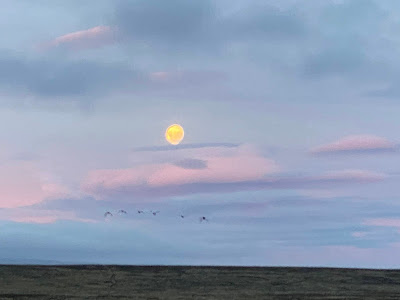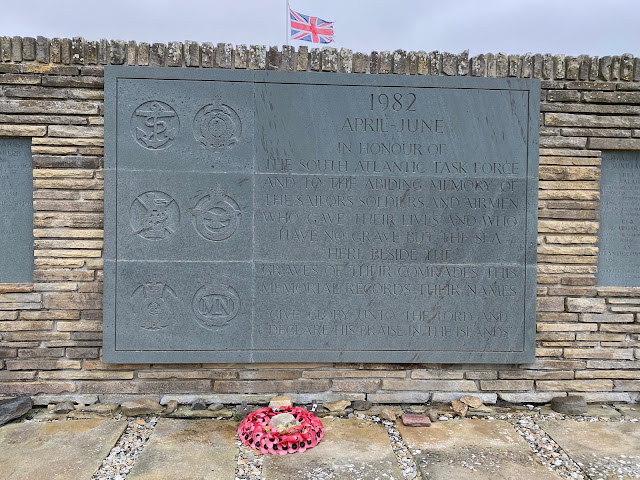Darwin, Saladero and San Carlos - 24-25 April 2021 No 23
This weekend twelve of us went to Darwin Lodge (yes, named after Charles…) and spent the weekend walking and enjoying mass dining. We were organised by the Director of Education – and were each given specific cooking responsibilities.
Darwin,
and the neighbouring settlement of Goose Green lie on a narrow isthmus of land
connecting the mountainous part of East Falkland with Lafonia – the southern flat,
and I mean ‘as a pancake’ flat part of East Falkland. Darwin Lodge is on the coast – however it
looks more like being on a lake shore as it is so far inland away from the ‘open
sea.’
Our
first expedition on Saturday morning, after what can only be described as a ‘stellar
breakfast’ – yes I was required to provide it and cook it with Geoff – we headed
to Saladero. This was a fascinating place. Saladero is the name given to the Department
of Agriculture’s national farm – where all manner of agricultural
experimentation takes place. It is also
home to the national sheep stud! The
sheep seem to have a collective herd – almost borg like collective
mindset. They’d stare us out in a tightly
bunched flock. Incidentally ‘Saladero’ is Spanish for a salting works typically
associated with salting animal hides.
remains of a building a Hope Place
Along the coast we came across the remains of ‘Hope Place’ – a saladero founded on the instructions of the Lafone brothers (Liverpool lads of French Huguenot extraction – whose financial failure led to the creation of the Falkland Islands Company – which is still going today). It is one of the few places where you can see the remains of stone buildings. En route to the abandoned settlement we passed a small grave marker – all that is left of their cemetery. The cemetery is being washed away by the sea – occasionally leading to the discovery of human bones!
The
weather on Sunday was murky – typically of a dark grey December day in the
UK. However we ventured to San Carlos –
and saw the Cemetery containing the bodies of UK Servicemen who died in the
1982 conflict whose bodies were not repatriated. We walked around the coast and could see across
the inlet where Commander Rick Jolly ran his hospital during the conflict.
The
coastline at this point was littered with scrap – including several land rovers.
We had lunch on top of a ridge overlooking San Carlos farm.
Our return to the cars was made all the more
exciting as we had to cross several electric fences! We
managed that without any of us receiving a shock – even though it did involve
holding fences up and rolling underneath them.
An old - kit built pair of settlement houses - note the metal cladding to the porch
Our 60 mile return drive to Stanley was made entirely in the dark. In that journey we saw three cars. Driving on gravel roads at night – even without any form of reflectors or edge protection isn’t an issue. The worst conditions I encountered was driving along a stretch of recently finished black top. It was the blackest of black and reflected very little light. To make matters worse there were no reflectors or white lines to help.
Now
for those of you into the Hitchhiker’s Guide to the Galaxy the importance of
having a towel cannot be understated.
Towels were meant to be provided at Darwin Lodge – they weren’t. This led to great hilarity and inventive use
of dish cloths!
“A
towel is just about the most massively useful thing an interstellar hitchhiker can carry. Partly because it has great practical value.
…
Any
man who can hitch the length and breadth of the Galaxy, rough it, slum it,
struggle against terrible odds, win through and still knows where his towel is,
is clearly a man to be reckoned with.”
Hitchhiker’s
Guide to the Galaxy













Comments
Post a Comment